Layouts
A Pennsylvania Train Story
Jun 29, 2011

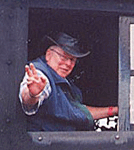
By Bill Rohm |
Author
Bio
For most of my adult life, I was a frustrated model railroader. I chose G scale for this indoor layout because I like to model and kit bash and because of the detail I wanted to model.
|
In the year 2000 my wife and I moved from a high-rise condominium just outside of Washington DC to a modest country estate in Juniata County, Pennsylvania. We had both recently retired from government service and were drawn to our central Pennsylvania roots.
We came because of my family history that was tied to this specific rural valley area. My Great Grandfather lived here in a railroad town called Patterson, later Mifflin. Thus I had a real tie to the Pennsylvania Railroad (PRR) in the early 1900's.
For most of my adult life, I was a frustrated model railroader. I became interested as a child of six when I got my first electric train for Christmas. It was made by Marx, a company that is long gone from the toy railroad scene. Having been constantly on the move for 30 years of military service, I had little time or space for model railroading.
Now I had both the room and a historical setting as a theme for a model railroad. I chose G scale for this indoor layout because I like to model and kit bash, and smaller scales were frustrating for my aging hands and eyes! I chose to build indoor over the garden primarily because of the detail I wanted to model.
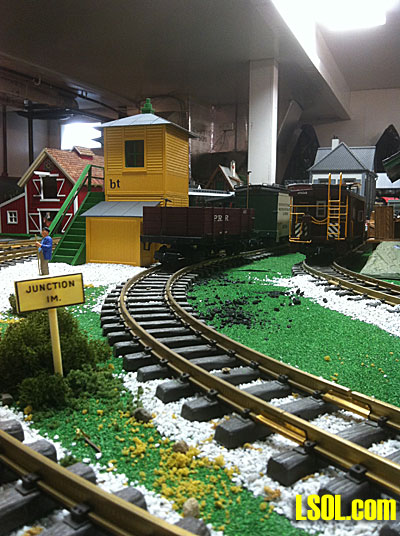
The switch tower for Patterson Junction
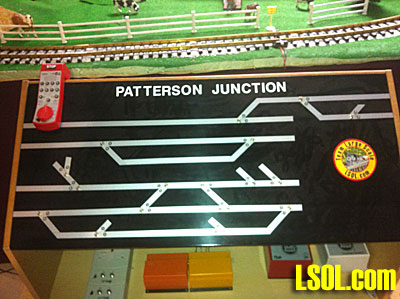
My controls for Patterson Junction. All turnouts are automated and controlled from this panel which sits near the control tower.
I centered my theme on Patterson Junction in early July 1900 when my Great Grandfather and his family lived here. Interested in family history, I'd done a lot of research through the Juniata County Historical Society. I also found some pictures from this era, and decided to replicate the area as it actually was, kit bashing buildings and condensing things to get a modified representation of railroading in this local area at this snapshot in time.
About 1850, Patterson was established as a site for locomotives to overnight too and get maintenance done between Philadelphia and Pittsburgh. A shop facility was built by the PRR, along with Patterson House. This was a combined station, restaurant, and hotel where passengers spent the night. It was by far the most elegant building in the area.
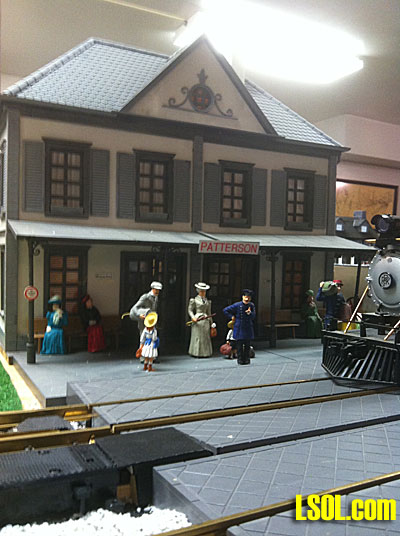
Patterson House; hotel, restaurant, and passenger station
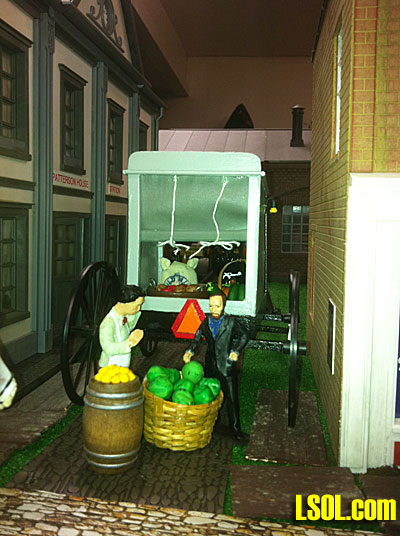 An Amish man barters with the cook out back of Patterson House.
An Amish man barters with the cook out back of Patterson House.
 Engine service facilities at Patterson.
Engine service facilities at Patterson.
The Patterson House is just to the right
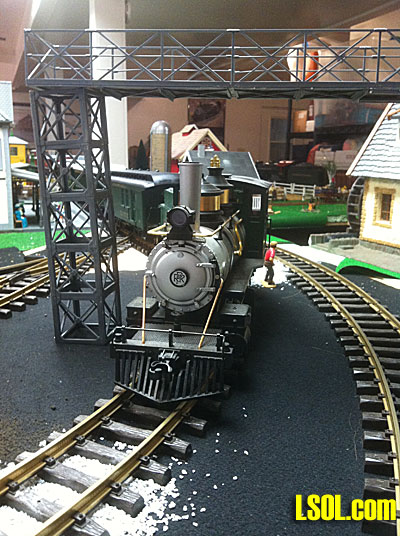
The Pennsylvania Limited leaving Patterson westbound
The county seat of Mifflintown was on the opposite bank of the Juniata River. Mifflintown provided the infrastructure for the small railroad town that grew on the west bank. Patterson was active as a rail repair center for only a few decades after which the large yard at Altoona was established. So by 1900, it was well past its prime.
Through traffic on the main lines included passenger trains both east and westbound including the Pennsylvania Limited and shorter frequent stop locals to move people from town to town. Freight trains carried a lot of coal from western Pennsylvania to the hungry furnaces of the growing industrial complex further east.
There was also local produce picked up from area farms and moved east for consumption. At one point, my Great Grandfather owned and operated a "market car". He bought local produce, hooked his modified box car to an east bound morning train to the State Capital of Harrisburg about 50 miles away, sold his goods right off the car at a siding at Harrisburg, and hooked up for a ride back to Patterson on the last westbound train of the day.
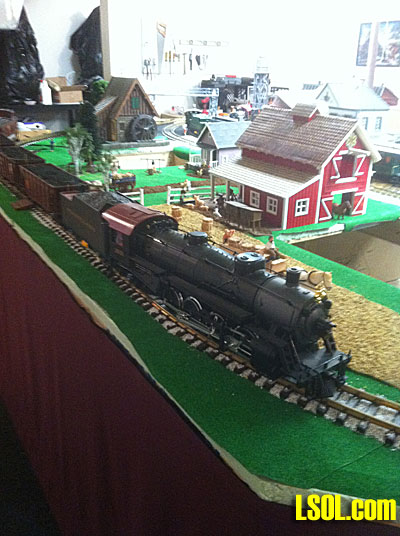
A coal consist heads east through the farm
land that surrounded the county seat
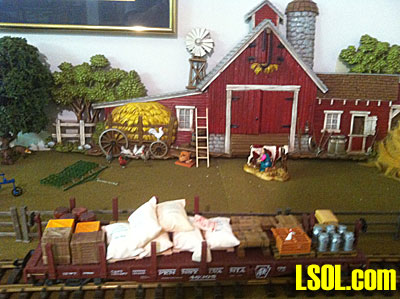
A loaded flat car waiting for pickup at a local farm siding
In addition to the PRR, there were several short line local railroads in the area that transported goods over their own track to junctions where they could be picked up by the PRR. The local that I chose as representative for my layout is the Kishacoquillas Valley Railroad (KVRR). This railroad was locally owned by bond holders, and consisted of about 40 miles of track. One old refurbished engine would make up to 10 round trips a day usually hauling one passenger car and one flat car to bring the farmers and their goods from villages to the county seat. They paid rent to the PRR for use of their maintenance, coaling, and watering facilities. I picked this one only because it originated at a town near the former home of my maternal grandparents.
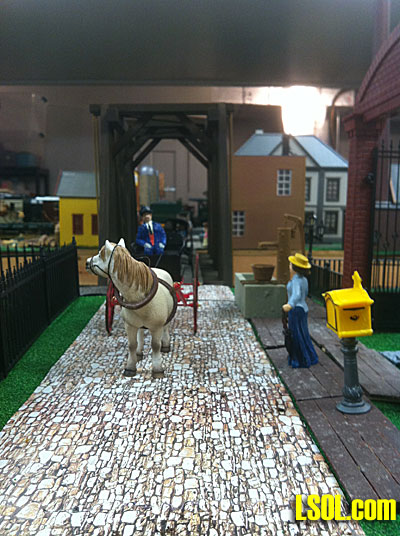
The wooden bridge over the
Juniata River
between Patterson and Mifflintown
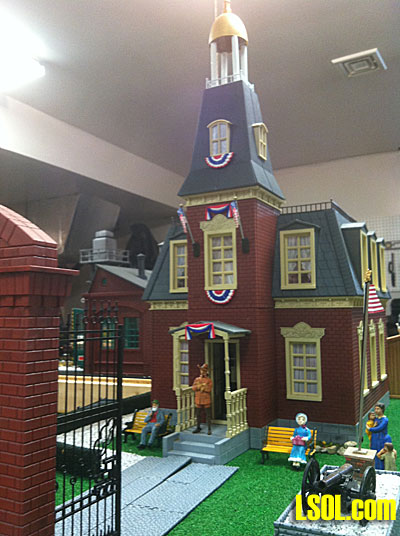
The County Court House in Mifflintown
decorated for the 4th of July
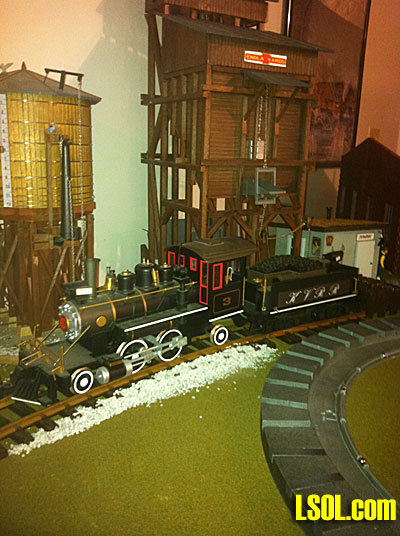
The KVRR locomotive at the coaling and watering facilities
Following are several more pictures of locations that I've mentioned in this story. My point to point extension added a mini version of the yards at Enola, about 30 miles from Patterson near Harrisburg at the confluence of the Juniata and Susquehanna rivers.
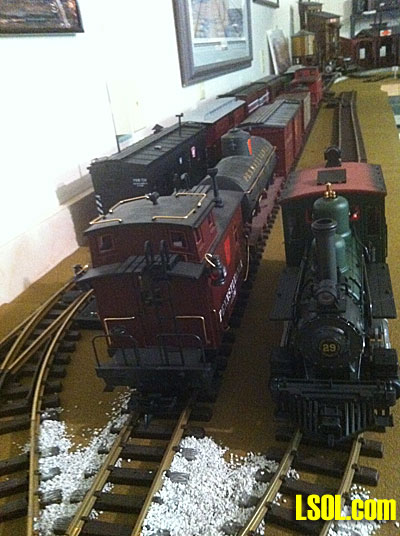
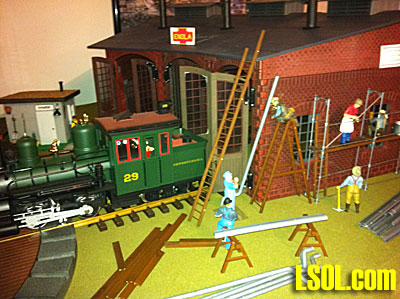
It ends with a turntable and roundhouse, which is still under construction, so that trains can be run in either direction. All of the locomotives are equipped with sound and LGB's multi train system (MTS) operating system.
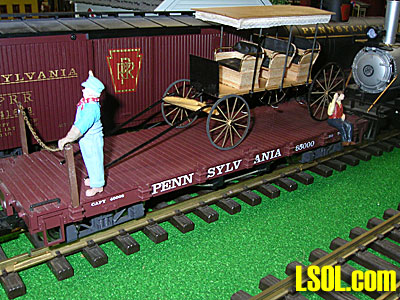
A surrey with a fringe on top is delivered to Mifflintown for local transportation.
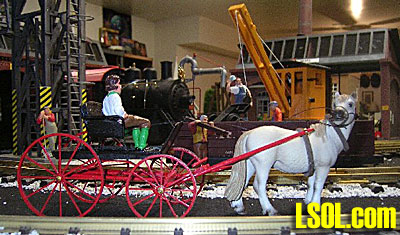
Inspecting the shops at Patterson
As all model railroaders know, one's layout is never finished. I've been working at this hobby for 10 years now. Having a fetish for minute detail, I still have many hours of enjoyment ahead; especially scratch building all sorts of buggies and harnesses for horses from old photos. Then there's the continuing need to acquire and paint figures in turn of the century garb. And I'm still looking for a picture of a period "market car" to build for my Great grandfather.
AND, I've even built the layout with an eye to operation point to point instead of just running in circles. I hope you've enjoyed "my little world". I do.
| Great Story |
| Bill, thanks so much for sharing the photos and story of your beautiful layout. The photos are excellent and the text very clear. Your telling about some of the history as well as the captions, let me understand your thinking about the scenes. And with it indoors, on those cold, snowy Pennsylvania nights, you can sit inside in comfort, sipping hot chocolate, and enjoy the layout. Bill N |
| Bill Ness - 06/29/2011 - 10:13 |
| Beautiful. |
| Bill Great job on the layout. Moving to Florida in 1956 from Allentown Pa, you have brought back Pennsy memories for me with your layout. Bruce |
| Bruce Benardo - 06/29/2011 - 17:03 |
| Step Back In Time |
| Excellent work capturing a slice of history. Good looking layout with nice detail. Thanks for sharing. |
| JD Miller - 06/30/2011 - 16:41 |
| Enjoyed your historical railroad in minature |
| Hi Bill, Now I see the "rest of the story".. Thanks so much for sharing.. I enjoyed seeing many towns that I remember hearing about or seeing in person at one time or another. And, of course, I loved seeing some of my "buggies" at work. Glad you have made them a part of your layout... I agree with Bill's comments, it is great to see an indoor layout from time to time, they make life so much easier in lots of ways, especially not having to deal with the elements... Great job... Keep up the fantastic work... Elaine |
| Elaine Haggenbottom - 06/30/2011 - 18:03 |
| Visit |
| Reminded me of my visits up the PA Amish Country in the 70's-80's... |
| Rick Henderson - 06/30/2011 - 18:22 |
| Wow great job |
| It was the word Kishacoquillas that forces me to write. I graduated from Penn State University and we would pass by Kishacoquillas H.S. on Rt. 322 on my way to school. What a great name for you line. Great pictures and a great layout. |
| John A. Baskin - 11/29/2012 - 14:50 |
Top of Page
|



